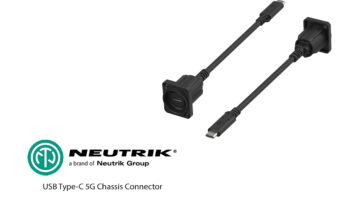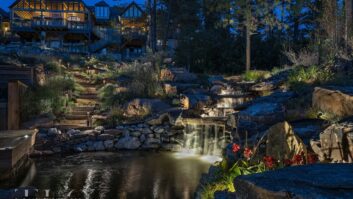ALL AT SEA
Apr 1, 2001 12:00 PM,
Keith Spencer-Allen
The Explorer’s A/V infrastructure is integrated with a main video control area, RCTV.
RCTV acts as a radio and TV station, handles all the entertainment satellite feeds and is responsible for the ship’s in-cabin interactive TV system
IT MUST HAVE BEEN YEARS since the arrival of a single cruise ship at Southampton created such interest. The PR machine had been working overtime for the previous week attracting the Daily Express and TV news to this story: The world’s newest and largest cruise liner had stopped over for a few days on her maiden voyage. Hundreds of people lined the shores of Southampton Water to watch her pass by, and a steady stream of visitors came to see if she was as big as they said — and she was.
The Explorer of the Seas berthed at Southampton Dock’s QE2 Terminal in early October. It is a sign of the times that this 142,000-ton, 1,020-foot-long ship is over twice the size of the QE2 itself. At 15 decks high, the Explorer dwarfs the terminal buildings.
All the ship’s numbers are immense. It will carry 3,114 passengers in great comfort but is licensed to carry over 5,000 passengers and a crew of 1,185. There is more deck space per passenger than any other cruise liner afloat (total deck space is nearly 700,000 square feet). The ship uses close to 1,900 miles of electric cable connected at around 60,000 different points, and that doesn’t even include the A/V facilities.
A FLEET OF GIANTS
The Explorer is the newest addition to the fleet of the US-based Royal Caribbean International cruise line. November 1999 saw the launch of Voyager of the Seas, the Explorer’s sister ship, only slightly smaller and the proving ground for much of the design and facilities included in the Explorer. Due in 2001 is The Adventurer of the Seas, still under construction. Two more ships will follow in what is known as the Voyager class. All are being built at the Kvaerner Masa-Yards at Turku, Finland, which the Explorer had left only days before arriving at Southampton, following 10 months of fitting-out and sea trials. The main purpose of the UK stopover during her maiden voyage was to allow 6,000 UK and European travel agents the opportunity to experience the ship and its facilities on two short cruises around the Channel Islands. The Explorer then sailed for New York for a naming ceremony before travelling to her home port in Miami where she started all-year-round weekly cruises of the eastern Caribbean.
For RCI, these ships represent considerable investments, estimated at around half a billion dollars each. The fantastic growth in the cruise segment of the tourist industry over the last decade represents a complete turnaround for what was once seen as an “older person’s vacation.” Jack Williams, president of Royal Caribbean International, acknowledged the changing trend: “The Voyager-class series is designed to capture the imagination of today’s vacationer and change the way people view cruising.” The current generation of cruise liners are small floating cities with a similar cross section of leisure activities and a depth of options to fill passengers’ cruise time that almost distracts from the fact that one is at sea. The areas where passengers can simply relax and watch the ocean pass by are fairly limited. Cruises are becoming activity holidays where being at sea is almost incidental. “We are in the leisure business,” commented a member of the Explorer’s crew when questioned about how the cruises are affected by bad weather. “If we see bad weather, we avoid it.”
ROYAL CARIBBEAN TELEVISION
Most of the more formal entertainment happens in two locations: The Palace Theater and Studio B, which aren’t totally freestanding areas because so much of the Explorer’s technical A/V infrastructure is integrated with a main video control area, known as RCTV, at its center.
RCTV acts as a radio and TV station, handles all the entertainment satellite feeds and is responsible for the ship’s in-cabin interactive TV system including the more complex multimedia requirements for the live shows. “Anything that is on TV or has a video screen is our responsibility,” explained head video programmer, Dave Foley, “and as you walk through the ship you will see that there are rather a lot of video screens.”
Foley is one of three video programmers who run RCTV, and a fourth just handles the interactive TV system. He is a veteran of four years with RCI, and on a schedule of weekly cruises where the tech crew spends six months on-ship followed by six to eight weeks off, that is a lot of cruises. Many of the tech crew on the Explorer also “test drove” the Voyager the previous year on her maiden voyage, spending time working with the installers, checking over the equipment and setting up the systems. On the Explorer, they were working with a lot of the same systems as they had on the Voyager, emphasizing that the A/V installations on these ships are rapidly becoming standardized.
All video installation was handled by TV Tools Oy of Helsinki, Finland, whose main business is supplying digital editing systems to Scandinavian broadcasters and post houses. The technique of building up and testing complete systems prior to installation, used with their broadcast clients, is paralleled in the needs of a commission for a cruise ship video system.
Feeds to support the 34 channels available on the passenger cabin TVs originate from RCTV, either via two satellite dishes on the upper deck area with eight receivers in the control room racks, or from a variety of different tape formats. The system supports channels in six languages including English.
The Explorer provides passengers with visual access to technical areas across the ship. In the same way that you can look down onto the Explorer’s high-tech bridge, most of the A/V technical areas have glass walls for interested passengers to view activities. The more photogenic equipment and editing systems in RCTV are on display, so tasks such as live video direction or program material editing become part of the ship’s entertainment.
THE PALACE THEATER
The largest of the Explorer’s entertainment venues is the 1,350-seat Palace Theater, a lavishly finished classic design that is five decks high with gently raked stalls, a raised seating area, and a balcony with 180° seating around a stage that extends into the audience area. The designers achieved a good balance between a local, live acoustic aided by the large areas of natural wood, and the rear walls that employ a quilted absorbency with a resulting short reverberation time throughout the theater. For a multifunction room that relies on amplification for all events, this is a sensible option. In general, there is no sense that you are on a ship, a matter of feet from the sea, nor are there any concessions apparent in terms of materials or weight because of it.
The theater hosts two “Wave Review” Broadway-style shows that are largely musical and based on movies. Each is performed twice during a week-long cruise and is set to run for a couple of years. In addition to this, there is a “Welcome Aboard” and a “Celebrity Showtime” show. Both change depending on the entertainers.
A permanent FOH mixing pit sits at the back of the stalls. It runs across two seating rows and is slightly raised for clear sight lines, with a wooden wall to prevent the operator from disturbing audience members seated nearby. The installed mixing console is a digitally controlled Euphonix CS3000, as used in the Voyager. Its snapshot recall of all audio settings is ideal for live shows that run to a repeated formula and have a very tight turnaround schedule between events. The console is surrounded by a host of machines and major outboard processing that includes Lexicon 480L reverb systems; four Tascam DA98 DTRS digital multitracks; two TC 6032 dynamic equalizers; DAT; audio cassette and MiniDisc players; Furman power conditioners; XTA Audio Core; compressors from TubeTech and BSS; EQ from Summit and TC; effects processors from Eventide, Lexicon and Yamaha; plus communications systems from Clear-Com and two IED5000 Series audio processors. A rack of 14 Shure UHF radio microphone receivers handle wireless needs. All quality appraisal of live signals and from recorded sources is handled by a pair of Genelec 1031 active monitors.
A small room behind the mixing pit and under the raised seating area has all the power amplifiers for the house speaker system and the Euphonix processing rack, and gives rear access to the patch and outboard bays — all air-conditioned. The main EAW-based sound reinforcement system is installed within the fabric of the structure and isn’t visible.
The theater has four automated Sony cameras with Canon lenses that can be controlled from the combined video/lighting control area in the balcony or fed back to RCTV for remote use. Further camera positions are available for occasional live game shows where RCTV takes a greater role in camera control. A bank of four video cubes on either side of the stage can be used to replay video or take camera feeds, originating locally or from RCTV. The rear of the stage can be covered by a Barco projector or PG Panoramic film projector as needed for the Wave Reviews.
STUDIO B
The other major entertainment location is Studio B, positioned conveniently near RCTV. This is a 900-seat multipurpose events arena with raked seating around three sides of a flat area and a small stage area at one end. The floor is the length of a basketball court (for which it is marked out). When more space is needed, one of the tiers of seating can hydraulically retreat. And if the area isn’t being used for the regular fashion shows, concerts or the live game show broadcasts, the floor can be rolled back to reveal the ship’s permanent ice-skating rink!
A gantry covers the floor area, packed with a computer-controlled lighting system that is featured in formal ice show presentations, although manually operated spots are positioned on dedicated platforms on two corners of the room. The three edges of the gantry facing the audience are loaded with Sony 27-inch video monitors, alternating with EAW speakers providing full coverage of the seated areas. Even beyond the seated areas, there are cocktail bars with standing height tables, more large video monitors at ceiling height and smaller EverFocus LCD screens at eye height. The concept is that wherever you are in this area, you cannot miss what is happening. In some positions, over 18 video monitors are visible without undue effort.
CONTROL ROOMS
There are totally separate control rooms for lighting, video and sound, all with glass walls to allow the curious to see everything happening, although the audio booth is open at the front, so the live sound can be monitored. The audio console is a Crest Century feeding into the EAW system suspended over the floor area. Again, Genelec monitors are used for quality control, as they are throughout all the ship’s A/V areas. Outboard audio gear follows the same high standard as the Palace Theater.
The video control room is far more integral to the shows. It creates feeds from the cameras to send to the 40 computer-controlled video cubes and the multiple video monitors. There are four fixed cameras; and at times there are three more — one wireless and two floor-mounted systems — added to handle a regularly broadcast 7-camera game show. The central control room can pick-up on any of these feeds and create programming for the TV channels when required.
The ship features high-standard video installation: a Sony DVS7200 switcher, Vinten Auto Cam system, Leitch Express switcher, Chyron Max!, three Video Commander VS64 visual routing systems, a host of support and playback equipment and Genelec 1031 audio monitoring. Broadcast-quality Betacam SP and digital SX are standard throughout the ship, and all areas are equipped to play them back.
RCTV NETWORK AND CONFERENCE FACILITIES
The RCTV center also handles additional TV programming on each cruise. There is a regular talk show, “Explorer Live,” that is recorded in different locations around the ship and directed from RCTV. Both the welcome and farewell shows are recorded, as is the programming about ports of call. During the week, there are three musical parades with bands through the Royal Promenade mall, covered by its own lighting and sound area, plus five automated permanent cameras that feed back to RCTV, allowing them to broadcast coverage.
The tech support crew is also responsible for the onboard conference facilities on the lower decks: one large room that can be run as four smaller areas, each with a plasma screen, a ceiling LCD projector, VHS/DVD players and computer facilities. A separate 60-seat screening room can be used for separate presentations.
As first installed in the Voyager, and now in the Explorer, interactive TV has extended passenger options right into each cabin. Designed by Allin Interactive, SeaVision is a special system for cruise liners. It provides numerous facilities such as access to electronic commerce services, enabling guests to choose a shore excursion, select wines for the evening’s dinner, review the status of an onboard charge account, select pay-per-view movies, read the online newsletter, order room service or even book another cruise, in a choice of six different languages.
In many ways, the video installation design can be viewed as a TV station that uses not only the designated entertainment areas but the complete ship as a TV studio in which to work. In this way, with links to the general A/V and communications infrastructure, the whole ship’s community is far more informed and integrated than might otherwise be possible in a mere seven days at sea.
AN AUSPICIOUS LAUNCH
As the Explorer of the Seas left Southampton for New York, there were still tests and tweaking being carried out. It had completed the two mini-cruises for travel agents, with large scale shows in both the Palace Theatre and Studio B. Carpenters were making minor additions to stage areas but would sort out any remaining glitches during the Atlantic crossing.
It’s amazing to think of the extent of the A/V systems onboard; and it’s even more amazing to recall that it is all just one part of a far greater whole. As one member of an installation team said, “Working on a ship this size is like cabling a small town for all its services in one go, with all the problems that would entail.” Many millions of installation hours later, the Explorer has just started earning money, as RCI prepares to roll out their next cruise liner.
Based in southeast England, Keith Spencer-Allen is a regular contributor to Sound & Video Contractor. He has two books in preparation, several studio development projects in hand, and several trade organizations as consulting clients.
FOR MORE INFORMATION
Barco
www.barco.com
Circle 235 on Reader Service Card
BSS Audio
www.bss.co.uk
Circle 236 on Reader Service Card
Canon
www.canon.com
Circle 237 on Reader Service Card
Chyron
www.chyron.com
Circle 238 on Reader Service Card
Clear-Com
www.clear-com.com
Circle 239 on Reader Service Card
Crest Audio
www.crestaudio.com
Circle 240 on Reader Service Card
Eastern Acoustic Works
www.eaw.com
Circle 241 on Reader Service Card
Euphonix
www.euphonix.com
Circle 242 on Reader Service Card
Eventide
www.eventide.com
Circle 243 on Reader Service Card
EverFocus
www.everfocus.com
Circle 244 on Reader Service Card
Furman Sound
www.furmansound.com
Circle 245 on Reader Service Card
Genelec
www.genelec.com
Circle 246 on Reader Service Card
Leitch
www.leitch.com
Circle 247 on Reader Service Card
Lexicon
www.lexicon.com
Circle 248 on Reader Service Card
Panoramic
www.panoramic.com
Circle 249 on Reader Service Card
Shure
www.shure.com
Circle 250 on Reader Service Card
Sony
www.sony.com
Circle 251 on Reader Service Card
Summit Audio
www.summitaudio.com
Circle 252 on Reader Service Card
Tascam
www.tascam.com
Circle 253 on Reader Service Card
TC Electronic
www.tcelectronic.com
Circle 254 on Reader Service Card
TubeTech
www.tubetech.com
Circle 255 on Reader Service Card
Vinten
www.vinten.com
Circle 256 on Reader Service Card
XTA Electronics Ltd.
www.xta.co.uk
Circle 257 on Reader Service Card
Yamaha
www.yamaha.com
Circle 258 on Reader Service Card
How to Entertain 3,000 People for a Week in the Middle of the Ocean
Though some people will have paid over 5,000 for a week’s “cruise,” there is almost an attempt to distract the passengers from the fact that they are on a ship. The key is to provide more than you could hope to do or visit in just seven days, including:
- Around 20 bars, many with entertainment
- Multiple swimming pools and hot tubs
- A sports center
- A golf simulator
- An in-line skating track
- A basketball court
- Live game shows
- A casino
- A rock-climbing wall
- Health and beauty centers
- An art gallery
- Internet access
- Onboard television channels in six languages
- The world’s only sea-going ice rink
And more! In every corner of the ship there are original art pieces, plasma screens with interesting facts or displays, and attractions such as the thermal imaging room. The Royal Promenade, an interior mall with shops and cafes, a ceiling height of four decks and an open-air ambience, runs through a center portion of the ship.










